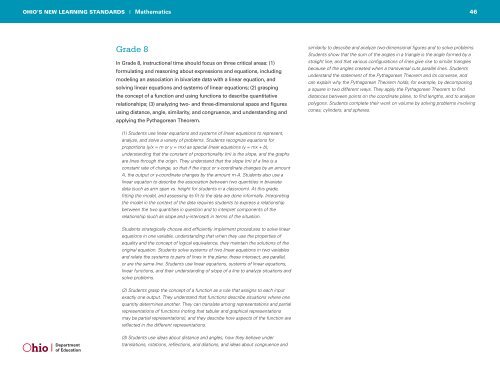Math-Standards.pdf
Math-Standards.pdf
Math-Standards.pdf
Create successful ePaper yourself
Turn your PDF publications into a flip-book with our unique Google optimized e-Paper software.
OHIO’S NEW LEARNING STANDARDS I <strong>Math</strong>ematics 46<br />
Grade 8<br />
In Grade 8, instructional time should focus on three critical areas: (1)<br />
formulating and reasoning about expressions and equations, including<br />
modeling an association in bivariate data with a linear equation, and<br />
solving linear equations and systems of linear equations; (2) grasping<br />
the concept of a function and using functions to describe quantitative<br />
relationships; (3) analyzing two- and three-dimensional space and figures<br />
using distance, angle, similarity, and congruence, and understanding and<br />
applying the Pythagorean Theorem.<br />
similarity to describe and analyze two-dimensional figures and to solve problems.<br />
Students show that the sum of the angles in a triangle is the angle formed by a<br />
straight line, and that various configurations of lines give rise to similar triangles<br />
because of the angles created when a transversal cuts parallel lines. Students<br />
understand the statement of the Pythagorean Theorem and its converse, and<br />
can explain why the Pythagorean Theorem holds, for example, by decomposing<br />
a square in two different ways. They apply the Pythagorean Theorem to find<br />
distances between points on the coordinate plane, to find lengths, and to analyze<br />
polygons. Students complete their work on volume by solving problems involving<br />
cones, cylinders, and spheres.<br />
(1) Students use linear equations and systems of linear equations to represent,<br />
analyze, and solve a variety of problems. Students recognize equations for<br />
proportions (y/x = m or y = mx) as special linear equations (y = mx + b),<br />
understanding that the constant of proportionality (m) is the slope, and the graphs<br />
are lines through the origin. They understand that the slope (m) of a line is a<br />
constant rate of change, so that if the input or x-coordinate changes by an amount<br />
A, the output or y-coordinate changes by the amount m·A. Students also use a<br />
linear equation to describe the association between two quantities in bivariate<br />
data (such as arm span vs. height for students in a classroom). At this grade,<br />
fitting the model, and assessing its fit to the data are done informally. Interpreting<br />
the model in the context of the data requires students to express a relationship<br />
between the two quantities in question and to interpret components of the<br />
relationship (such as slope and y-intercept) in terms of the situation.<br />
Students strategically choose and efficiently implement procedures to solve linear<br />
equations in one variable, understanding that when they use the properties of<br />
equality and the concept of logical equivalence, they maintain the solutions of the<br />
original equation. Students solve systems of two linear equations in two variables<br />
and relate the systems to pairs of lines in the plane; these intersect, are parallel,<br />
or are the same line. Students use linear equations, systems of linear equations,<br />
linear functions, and their understanding of slope of a line to analyze situations and<br />
solve problems.<br />
(2) Students grasp the concept of a function as a rule that assigns to each input<br />
exactly one output. They understand that functions describe situations where one<br />
quantity determines another. They can translate among representations and partial<br />
representations of functions (noting that tabular and graphical representations<br />
may be partial representations), and they describe how aspects of the function are<br />
reflected in the different representations.<br />
(3) Students use ideas about distance and angles, how they behave under<br />
translations, rotations, reflections, and dilations, and ideas about congruence and


